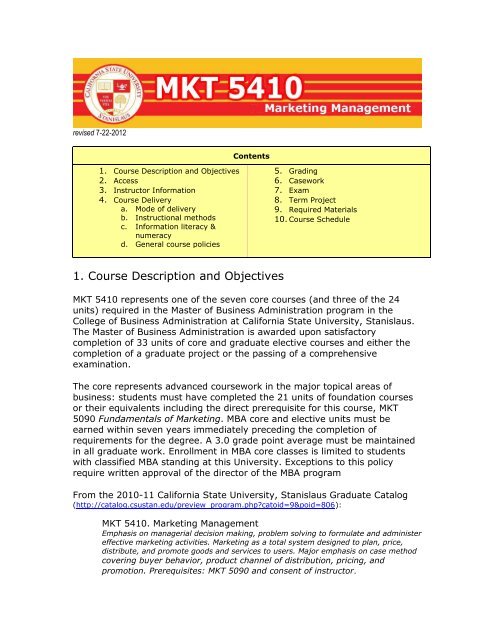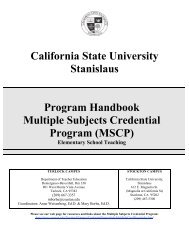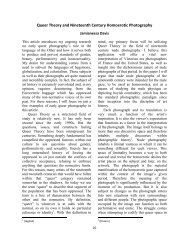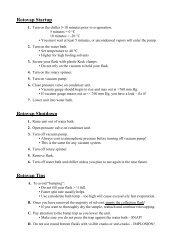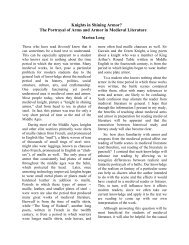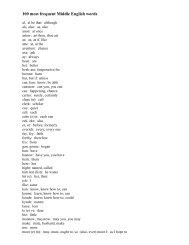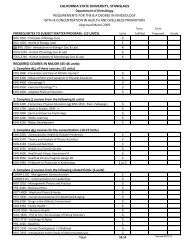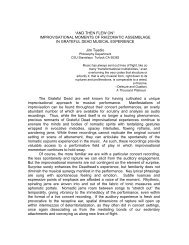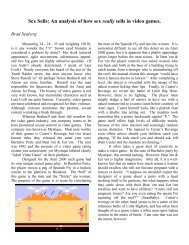Course syllabus - CSU Stanislaus
Course syllabus - CSU Stanislaus
Course syllabus - CSU Stanislaus
You also want an ePaper? Increase the reach of your titles
YUMPU automatically turns print PDFs into web optimized ePapers that Google loves.
evised 7-22-2012<br />
1. <strong>Course</strong> Description and Objectives<br />
2. Access<br />
3. Instructor Information<br />
4. <strong>Course</strong> Delivery<br />
a. Mode of delivery<br />
b. Instructional methods<br />
c. Information literacy &<br />
numeracy<br />
d. General course policies<br />
Contents<br />
1. <strong>Course</strong> Description and Objectives<br />
5. Grading<br />
6. Casework<br />
7. Exam<br />
8. Term Project<br />
9. Required Materials<br />
10. <strong>Course</strong> Schedule<br />
MKT 5410 represents one of the seven core courses (and three of the 24<br />
units) required in the Master of Business Administration program in the<br />
College of Business Administration at California State University, <strong>Stanislaus</strong>.<br />
The Master of Business Administration is awarded upon satisfactory<br />
completion of 33 units of core and graduate elective courses and either the<br />
completion of a graduate project or the passing of a comprehensive<br />
examination.<br />
The core represents advanced coursework in the major topical areas of<br />
business: students must have completed the 21 units of foundation courses<br />
or their equivalents including the direct prerequisite for this course, MKT<br />
5090 Fundamentals of Marketing. MBA core and elective units must be<br />
earned within seven years immediately preceding the completion of<br />
requirements for the degree. A 3.0 grade point average must be maintained<br />
in all graduate work. Enrollment in MBA core classes is limited to students<br />
with classified MBA standing at this University. Exceptions to this policy<br />
require written approval of the director of the MBA program<br />
From the 2010-11 California State University, <strong>Stanislaus</strong> Graduate Catalog<br />
(http://catalog.csustan.edu/preview_program.php?catoid=9&poid=806):<br />
MKT 5410. Marketing Management<br />
Emphasis on managerial decision making, problem solving to formulate and administer<br />
effective marketing activities. Marketing as a total system designed to plan, price,<br />
distribute, and promote goods and services to users. Major emphasis on case method<br />
covering buyer behavior, product channel of distribution, pricing, and<br />
promotion. Prerequisites: MKT 5090 and consent of instructor.
COURSE OBJECTIVES: To amplify on the broad principles and perspectives<br />
learned in prerequisite marketing coursework, and supply both organizationspecific<br />
and environmental context to marketing decision-making. Casework<br />
takes these principles and asks the student to apply them in a limited<br />
context, such as focusing on a given company's media planning,<br />
segmentation strategy, or pricing policy. Exercises emphasize drill with tools<br />
required for quantitative analysis in marketing management. The assigned<br />
project takes the principles and asks the student to apply them in a more<br />
integrated context, taking the marketing problem and following it through<br />
many aspects of decision-making. Throughout, the intention is to prepare the<br />
student to identify marketing problems and opportunities, identify options<br />
available, and choose appropriate solutions.<br />
COURSE OUTCOMES: On successful completion of this course, the student<br />
should be able to:<br />
1a. Perform basic financial calculations necessary for marketing analysis,<br />
such as breakeven analysis, contribution analysis, cannibalization<br />
analysis, and customer lifetime value.<br />
1b. Recognize the situational need for basic financial calculations in the<br />
context of a marketing case.<br />
1c. Utilize these calculations in service of analyzing case materials,<br />
comparing and contrasting alternative solutions to the problem<br />
presented in the case, and justifying the ultimate proposed decision in<br />
the case.<br />
1d. Utilize these calculations in service of analyzing the current situation of<br />
a real-life client in preparation of a marketing plan.<br />
2a. Perform simple forecasting techniques.<br />
2b. Integrate simple forecasting techniques in service of a marketing plan.<br />
3a. Calculate financial ratios and utilize in service of benchmarking.<br />
3b. Use financial ratios to analyze health of organization in a case analysis,<br />
as well as analyze the client organization for the creation of a<br />
marketing plan.<br />
3c. Compare financial ratios of case organization (or, for marketing plan,<br />
the client organization) to other similar organizations utilizing readilyavailable<br />
published standards (i.e. Robert Morris Associates data,<br />
Standard & Poor’s, or Bizstats).
4a. Identify the major elements of a marketing plan, including<br />
environmental assessment, target market selection, product decisions,<br />
pricing decisions, distribution decisions, and promotion decisions .<br />
4b. Recognize and diagnose problems regarding specific marketing mix<br />
elements of product, price, distribution, and promotion, in service of<br />
marketing case analysis.<br />
4c. Recognize and diagnose problems of a synthetic nature, involving the<br />
simultaneous interaction of multiple marketing mix elements in service<br />
of creating a marketing plan.<br />
2. Access<br />
Technical Requirements. The student is strongly encouraged to have<br />
broadband access to the internet, as this course will occasionally require<br />
downloading large files to complete assigned tasks. The following are<br />
minimum requirements for successful interaction with the platform and<br />
course components:<br />
� A PC running Microsoft Vista or Windows 7 (computers running the<br />
XP operating system may experience difficulties, sometimes<br />
freezing or crashing)<br />
� Internet Explorer 7 or above<br />
� Microsoft Office 2007 or newer. Access to and familiarity with Excel<br />
spreadsheets is essential for the successful completion of course tasks.<br />
Assignments and exercises will also need to be completed in Word<br />
document or pdf format. Some group or individual work will require<br />
the student to develop an audio-augmented PowerPoint presentation.<br />
� Adobe Acrobat Reader and Adobe Flash (latest versions available at<br />
www.adobe.com). Note that some contents will not be accessible by<br />
some mobile devices.<br />
The student may also find other communication software of use during the<br />
execution of group exercises, such as Skype. Some office hours may be<br />
conducted utilizing Elluminate/Collaborate, the access to which the instructor<br />
will provide later in the semester; some functions of this software will be<br />
easier to use if the student has access to a headset with microphone. The<br />
instructor may also occasionally require the student to download exercisespecific<br />
free software, so additional free space on your hard drive is a must.<br />
The course will also make use of proprietary databases accessible by proxy<br />
through the <strong>CSU</strong> <strong>Stanislaus</strong> Library website. Other helpful websites and their<br />
links will be provided in the “links” section of the course Blackboard,<br />
including:<br />
� US Census American Factfinder<br />
� Claritas PRIZM<br />
� NAICS code lookup and NAICS/SIC conversion
� Forbes INVESTOPEDIA Financial Ratios Tutorial<br />
� Bizstats<br />
� Kellogg School Cannibalization Analysis note<br />
� Online Interactive Statistical Calculators<br />
� UBaltimore Smoothing Calculator, and more<br />
The majority of course components will be facilitated via the campus<br />
Blackboard learning management system. Weekly assignments will be made<br />
available through this course Blackboard, and regular visits throughout the<br />
week will be required. Blackboard news, system maintenance and<br />
availability, and mobile options, as well as helpful suggestions for students<br />
experiencing difficulties navigating Blackboard may be found at:<br />
http://www.csustan.edu/Blackboard/StudentHelp/MovingAround.html<br />
Disability Accommodations. Disabled students may be eligible for<br />
accommodations, for more information, please visit:<br />
http://www.csustan.edu/DRS/<br />
Office Hours. The instructor will be available Mondays 4-5 pm Mondays and<br />
10-11am Tuesdays by phone or in person in his office on the <strong>CSU</strong> <strong>Stanislaus</strong><br />
Main Campus in Turlock, CA. Contact information is provided in the next<br />
section.<br />
Once the students have provided some personal information at the beginning<br />
of the semester, the instructor will also schedule additional web office hours<br />
utilizing the interactive Collaborate system, which will allow for audio-visual<br />
contents, at<br />
https://sas.elluminate.com/m.jnlp?sid=2009440&password=M.AC295768BFE<br />
3FEF21270DAE3DCD384<br />
The student may also wish to contact the instructor with questions or<br />
comments by:<br />
� e-mail at apetrosky@csustan.edu . The instructor will make an effort<br />
to respond to e-mails left Monday through Thursday within 24 hours.<br />
The instructor regularly checks his e-mails on Monday and Wednesday<br />
afternoons and Tuesday and Thursday mornings.<br />
� Discussion Board comments on the course blackboard under<br />
“Kvetching.”
3. Instructor Information<br />
Dr. Al Petrosky<br />
Professor of Marketing<br />
Chair, Dept. of Management, Operations and Marketing<br />
College of Business Administration<br />
Demergasso-Bava Hall 223A<br />
<strong>CSU</strong> <strong>Stanislaus</strong>, 1 University Circle, Turlock, CA 95382<br />
Office Phone: (206)667-3019<br />
Department Secretary: (209)667-3907<br />
Department Facsimile: (209)667-3210<br />
Email: apetrosky@csustan.edu<br />
Dr. Petrosky teaches Fundamentals of Marketing, Marketing Management,<br />
Advanced Marketing Research, and Physical Distribution at the graduate<br />
level. He also teaches Marketing Research, Advertising and Promotions<br />
Management, and Channel Management at the undergraduate level. He<br />
earned his doctorate in Marketing from the University of Arizona, his MBA<br />
from the University of Utah, and a Bachelor's Degree in Engineering from the<br />
University of Washington. Dr. Petrosky's research interests include the<br />
diffusion of innovations, consumption of aesthetic products, and ethnographic<br />
research techniques. He currently serves as Chair of the Department of<br />
Management, Operations and Marketing; has acted as Program Chair for the<br />
International Conference on Industry, Engineering, and Management<br />
Systems (IEMS) for the last 16 years; and has been a past Faculty Speaker<br />
for <strong>CSU</strong> <strong>Stanislaus</strong>.<br />
4. <strong>Course</strong> Delivery<br />
Mode of Delivery. The MKT 5410 course will be delivered entirely online:<br />
no face-to-face attendance will be required. In lieu of an initial in-person<br />
meeting, an introductory recorded orientation will be made available early in<br />
the first week; a link will be e-mailed the week before class.<br />
All materials will be made available through the Blackboard portal on the <strong>CSU</strong><br />
<strong>Stanislaus</strong> website, or directly through the following URL:<br />
http://www.csustan.edu/Blackboard/<br />
Directions for student login are available on the rightmost column of this<br />
page, as is a link to the blackboard administrator’s e-mail should you have<br />
any questions or difficulties regarding access. It is strongly recommended
that the student regularly check his/her assigned StanMail e-mail account, or<br />
otherwise arrange for messages sent to this account to be forwarded to an<br />
account he/she frequently check (for instructions on forwarding, see:<br />
http://www.csustan.edu/cms/FormsPublications/Documents-<br />
Students/StudentEmail-Forwarding.pdf )<br />
The student is strongly encouraged to have broadband access to the internet,<br />
as this course will occasionally require downloading large files to complete<br />
assigned tasks. The student should also verify his/her ability to download<br />
files utilizing Adobe Flash, otherwise some course components will not be<br />
accessible (Apple iPad and iPhone users, this means you!).<br />
Instructional Methods. Marketing 5410 is intended as an amplification of<br />
the principles and practices of marketing in a rich context of real-life<br />
organizational settings. As such, it will provide an overview of the broad<br />
spectrum of marketing functions, the basic underlying concepts which drive<br />
marketing decisions, and the symbiotic nature of marketing with other<br />
business functions and society as a whole. To accomplish this, the following<br />
methods will be employed:<br />
� The textbook will introduce the basic concepts, issues, and terminology<br />
of Marketing, along with the cases to demonstrate them and allow for<br />
discussion and implementation in context.<br />
� Mini-lectures (pre-recorded weekly audio-only orientations and<br />
audiovisual lectures posted to the Blackboard) will be provided on a<br />
regular basis to provide additional emphasis on material covered in the<br />
textbook and readings, or to demonstrate analytical procedures in aid<br />
of marketing decisions<br />
� Exercises will be assigned to provide the student the opportunity to<br />
practice skills and/or provide context to illustrate the topics introduced<br />
in the textbook, readings and mini-lectures.<br />
� Online discussions require the students to engage in in-depth analysis<br />
of a case pertinent to the topic of the week, and to share that analysis<br />
with the other students in the course. Often, the issues will revolve<br />
around the consumer perspective of marketing actions, and will<br />
involve students sharing an opinions and analyses.<br />
Information literacy and numeracy. Given the outlined prerequisites<br />
to the course, the student is expected to have already completed coursework<br />
to provide grounding in information literacy and numeracy. This grounding<br />
shall be expanded upon in the context of marketing management, amplifying<br />
on the necessity of both qualitative and quantitative analysis in arriving t<br />
some solution: .<br />
Information literacy:<br />
� For Benchmarking. The student will be exposed to several information<br />
sources to assist in benchmarking the performance of organizations
described in their casework, as well as the client organization they<br />
have selected for their term project. These will include databases that<br />
provide comparative financial ratio data (e.g. Net Advantage on our<br />
Library website, as well as free web sources like<br />
http://www.bizstats.com/industry-financials.php ), governmentsponsored<br />
websites for individual organizational filings<br />
(http://www.sec.gov/edgar.shtml ) and -- for student with some<br />
physical, proximal access to a library such as our own, bound<br />
proprietary databases (e.g. Robert Morris Associates Annual Statement<br />
Studies).<br />
� For Historical and/or Trend Assessment. Many of the corporations<br />
highlighted in the accompanying cases are real-life, identified<br />
corporations operating in a complex environment; as such, the student<br />
may find it helpful to go beyond the information provided in the case<br />
for a better understanding of the history of the company, history of the<br />
industry, history of that industry’s political and legal environment, and<br />
any operative trends in therein. The <strong>CSU</strong> <strong>Stanislaus</strong> library website<br />
provides many useful databases – including, but not limited to, ABI<br />
Inform and Factiva – which may be helpful in delineating these<br />
histories.<br />
� For Elaboration of the Target Market. All marketing organizations need<br />
to consider their target market. The instructor will encourage the<br />
exploration of both government-sponsored websites (e.g.<br />
http://factinder2.census.gov ) and proprietary databases (e.g. Claritas<br />
and Nielsen) that assist in drawing boundaries for target markets.<br />
Numeracy:<br />
� Marketing-related Financial Analysis. The student will receive<br />
demonstration and drill in such financial analysis that directly<br />
influences marketing decision-making, such as breakeven analysis and<br />
cannibalization analysis<br />
� Financial Ratio Data. As mentioned in the previous section, financial<br />
ratios are used to benchmark and diagnose the health of a given<br />
organization. Demonstration and drill will be accomplished in week<br />
four, and these ratios will be applied in the casework and term project.<br />
� Forecasting. Determining the future value of sales, market share, or<br />
other marketing outcomes is necessary in the evaluation of alternative<br />
strategies. Simple forecasting techniques will be demonstrated and<br />
drilled in week eight, and required for use in the term project.
General <strong>Course</strong> Policies. The following policies are in effect:<br />
Attendance: Though there are no “physical” attendance requirements, the<br />
student is expected to login to the course regularly and complete the<br />
assigned tasks in a timely manner. The student should expect a weekly<br />
average 10-15 hour workload to stay current.<br />
Promptness: Each weekly module will begin at 12;01 AM PDT Wednesday<br />
and end 11:59 PM PDT Tuesday the next week. All cases and exercises are<br />
due by 11:59 of the second Tuesday unless otherwise specified. Online<br />
Discussions will likely require multiple visits throughout the week: each<br />
weekly discussion thread will be made available by 12:01 AM PDT the<br />
Wednesday and close at 11:59 PM PDT the next Tuesday. The times will<br />
remain the same following the change from daylight to standard time.<br />
Late work: No case participation or exercises will be accepted after the<br />
module closes at 11:59 PM the second Tuesday, and zero points will be<br />
awarded those who fail to submit on time. Participation in online discussions<br />
will be awarded point only during the week the thread is live: zero points will<br />
be awarded those who fail to submit on time.<br />
Missed quizzes: There will be no make-up examinations given. Missing a<br />
quiz will result in zero points for that portion of the grade.<br />
Plagiarism. Plagiarism (as defined by Macquarie University's Library<br />
website) involves using the work of another person and presenting it as one’s<br />
own. Any of the following acts constitutes plagiarism unless the source of<br />
each quotation or piece of borrowed material is clearly acknowledged:<br />
� Copying out -- in part or in whole -- of any document or audio-visual<br />
material (including computer-based material);<br />
� Using or extracting another person’s concepts, experimental results, or<br />
conclusions;<br />
� Summarizing another person’s work;<br />
� In an assignment where there was collaborative preparatory work,<br />
submitting substantially the same final version of any material as<br />
another student.<br />
Encouraging or assisting another person to commit plagiarism is a form of<br />
improper collusion and may attract the same penalties, which apply to<br />
plagiarism. Plagiarism of any degree found in the work submitted for this<br />
course by any student will result in penalties including -- but not restricted to<br />
-- loss of credit for that assignment, a failing grade for the course regardless<br />
of performance in other course requirements, or (in particularly egregious<br />
cases) suspension from the University. Note that the combining of several<br />
different sources without acknowledgement (or "pastiche") is no less<br />
plagiaristic than the utilization of a single source. For a more detailed<br />
treatment of the subject, see this article at the UC Davis website:<br />
http://sja.ucdavis.edu/files/plagiarism.pdf
Netiquette: Professional, respectful communications behavior in an online<br />
community is an absolute necessity for a productive environment, but novice<br />
online participants often don’t understand the differences between online and<br />
the real world. For tips regarding online etiquette, see<br />
http://www.csustan.edu/Blackboard/Netiquette.html.<br />
General Conduct: The Student Code of Conduct may be found online<br />
at this address:<br />
http://www.csustan.edu/JudicialAffairs/documents/StudentConductCod<br />
ev2008.pdf
�<br />
5. Grading<br />
Each student's course grade will derive from the accumulation of points<br />
across several components:<br />
Component Points % grade<br />
Five Quizzes @ 20 points each 100 25<br />
Eight exercise sets @ 5 points each 40 10<br />
Term Project Marketing Plan 100 25<br />
Individual Case Exam 80 20<br />
Individual Case Discussion Participation 80 20<br />
� Plus/Minus Grades will be given in this course: i.e. A, A-minus, Bplus,<br />
B, B-minus, etc.<br />
� Grades will reflect both absolute (objective with respect to the<br />
student's ability to complete assigned tasks) and relative (compared<br />
to the demonstrated contribution of peer students) quality of the<br />
student's work.<br />
The assignment of course grades will reflect the student's relative<br />
standing among his/her classmates across all exams and assignments<br />
taken as a whole. Approximate grade ranges for individual<br />
assignments and exams will be explained as they are returned.<br />
Accumulated point range guarantees are in effect:<br />
A: 92% or greater A- : 89% to 91.9%<br />
B+ : 85% to 88.9% B : 82% to 84.9%<br />
B- : 79% to 81.9% C+ : 75% to 78.9%<br />
C : 72% to 74.9% C- : 69% to 71.9%<br />
D+ : 65% to 68.% D : 62% to 64.9%<br />
D- : 59% to 61.9% F : 58.9% and lower<br />
These ranges are guaranteed to the high side: they will in all likelihood<br />
be some relaxing of the ranges downward given difficulty of individual<br />
exercise elements and exams, but they are guaranteed not to be<br />
adjusted higher than these given ranges.<br />
Quizzes. There will be five quizzes, each covering material in two of<br />
the Chapters 1 through 10 in the Farrell/Hartline text (for example,<br />
Quiz One takes place at the end of the second week, and will cover the
assigned chapters 1 and 5 – see <strong>Course</strong> Schedule for information<br />
regarding chapters covered and date quiz is deployed); most of this<br />
material should constitute review for anyone who has met the<br />
prerequisite requirement of an Introduction to (or Fundamentals of)<br />
Marketing course (such as our own MKT 3410 or MKT 5090). Each will<br />
be deployed through the Assignments section of the course<br />
Blackboard. Each will be made available for a 48 period: logon any<br />
time in that 48-hour period to take the quiz. A timer will limit you<br />
starting the moment you launch the quiz. You will not be able to take<br />
the quiz more than once, so be sure you are connected through a<br />
reliable service. Quiz will be comprised of multiple choice, fill-in-theblank,<br />
short essay, and problem types of questions. Each quiz will<br />
have 15-20 questions, and be worth 20 points. Each quiz is to be done<br />
individually. Questions may be drawn from a testbank, and exact<br />
sequence and number of questions may be unique to the student.<br />
Exercise sets. There will be eight exercise sets assigned during the<br />
semester. The exercises will sometimes draw upon the textbook<br />
reading of the week, but will at other times be related to the material<br />
covered in the recorded Tools Lecture of the week. Each exercise set<br />
will be worth 5 points, and will be due by Tuesday at 11:59 by e-mail<br />
to the instructor: these e-mails should have a subject line that reads<br />
“Online 5410 (your last name).”<br />
6. Casework<br />
Every student is expected to have read and contemplated each of the cases<br />
discussed in class.<br />
The case discussion should regularly follow along these lines: Brief summary<br />
of the "current" situation described in case<br />
� SWOT analysis<br />
� Company Strengths<br />
� Company Weaknesses<br />
� Environmental Opportunities<br />
� Environmental Threats<br />
� Environmental issues<br />
� Issues related to the Target market<br />
� Issues pertinent to the topic of the week<br />
� Casewriter's perspective of the Problem at Hand<br />
� Any "hidden" problems that need to be addressed<br />
� Alternative solutions: each proposed solution should list advantages<br />
and disadvantages inherent to that solution, with any analysis required<br />
to support that solution
� Product-related<br />
� Price-related<br />
� Place-related<br />
� Promotion-related<br />
� Decision<br />
� Implementation strategies/suggestions<br />
� Contingencies that need to be planned for<br />
A demonstration case will be used in the second week of the term.<br />
The Blackboard Discussion Board will have unique threads for each case, and<br />
the student should make initial, original posts regarding these topics for each<br />
of the cases. Any student need not post for every SINGLE subtopic, but<br />
should make a minimum of three initial posts, one of which concerns the<br />
weighing of alternative actions leading to a solution. The student should also<br />
return during the week to pick up on the line of discussion and respond to<br />
the posts of other students and the instructor.<br />
The majority of the cases we prepare concern real-life, undisguised<br />
corporations. If you would like to see some characterization of the company<br />
and its competitors, Hoovers.com descriptions are available from ABI/Inform,<br />
one of the databases available through the university library website. The<br />
lead team is not expected, nor is asked to, provide an exhaustive analsis, but<br />
rather provide the framework for the week’s discussions.<br />
Individual case discussion participation<br />
A SIGNIFICANT portion of student efforts shall be directed toward weekly<br />
participation in discussions of the solution of the week’s detailed cases. Each<br />
student is expected to digest the material assigned for the given class period,<br />
and be able to constructively contribute to its discussion. Failure to<br />
participate in that’s week’s case discussion will result in a zero score, and<br />
makeup is not available.<br />
Not including the demonstration case (Sea-link) or the Case Exam (week 12,<br />
to be done individually), and factoring in that there is no case in week 8,<br />
there are a total of eight case discussions during the semester, and up to ten<br />
points will be awarded per case. Participation posts on each weekly case<br />
discussion will be graded on that ten-point scale – based on relative and<br />
absolute contribution -- and percentage of total possible points for the<br />
semester will determine your grade for this element. Assessment of<br />
individual participation on each weekly discussion will be rewarded on<br />
originality of each post, clarity of position on each post, willingness/ability to<br />
incorporate information from additional sources to strengthen and augment<br />
stated position, utilization of qualitative and quantitative analysis techniques<br />
to bolster argument, and the individual’s amount of participation relative to<br />
classmates. Minimum expected amount of participation would include three<br />
(3) original posts and three (3) responses to peer posts. Use the following as
a guideline to perceived strength/quality of posts. A rubric that will be used<br />
in the grading of weekly participation is provided as an appendix to this<br />
<strong>syllabus</strong>.<br />
7. Case Exam<br />
In the twelfth week of class, students will be given a marketing case of some<br />
comprehensive nature as a “take-home” exam. This exam is worth up to 80<br />
points. Each student is expected to work independently and turn in their own<br />
unique solution to the case in a week's time (exact due date is indicated in<br />
the course schedule). The solution should follow these parameters:<br />
� It is expected that the student will submit the product of his/her own<br />
work; plagiarism -- in whole or pastiche -- will result in a failing grade<br />
for the course. Any supportive quotations or data from sources outside<br />
of the case itself should be duly documented in a bibliography, and<br />
should not constitute the greater proportion of the solution text.<br />
� The text of the solution must be typewritten, and is limited to 2000<br />
words maximum. The student is allowed no more than eight tables,<br />
figures or diagrams in support of the text.<br />
� Solution particulars should follow the same outline as our weekly case<br />
discussions.<br />
� The solution may be submitted as a Microsoft Word document or pdf<br />
transmitted via e-mail to apetrosky@csustan.edu : in either case, the<br />
student should keep a copy available should the original be lost or<br />
ineffectively transmitted.<br />
Further instructions will be provided at the time of assignment.<br />
8. Term Project<br />
The student is expected to recruit a local client organization for the purposes<br />
of constructing a marketing plan; this client organization may be public or<br />
private, profit or not-for-profit, product- or service-oriented, the business<br />
you own or work for -- whatever.<br />
Since you will need financial and other quantitative data to<br />
complete the marketing plan, you must ascertain whether<br />
these are readily available and/or willingly provided by the<br />
client: marketing plans not including said data will be<br />
substantially penalized.<br />
The form of the marketing plan is as detailed in the appendix of your text,<br />
and further elaborated in the exercise of week three. Materials described<br />
week by week throughout the course will be helpful. The first half of the
suggested Cohen supplement book contains many tools which may be used<br />
in analyzing the company at hand; the second half contains many samples of<br />
marketing plans for a number of different types of organizations.<br />
These projects should be done individually or in groups of two students. The<br />
output will be a paper and a PowerPoint-based overview presentation of the<br />
plan available for peer scrutiny and comment the final weeks of class.<br />
� The paper should be approximately 12-15 double-spaced pages in<br />
length with regards to text. Supporting exhibits, tables, graphs,<br />
documents should be provided in an appropriately-referenced<br />
appendix, and does not count toward the 12-15 page count. This<br />
appendix is also the appropriate place for including any support<br />
materials derived from the workbook exercises/tools found in Cohen.<br />
You must provide the instructor an e-mail Word or pdf of the paper<br />
and PowerPoint, delivered with the subject line “Online 5410 Plan<br />
(your last name).”<br />
� The presentation should be recorded on Screencast-O-Matic, which<br />
provides free access on their website. It will be given in the<br />
penultimate week of class, and be placed on the Blackboard website<br />
for comment by other students. It is meant to be an overview of your<br />
project, lasting 5-7 minutes, and need not be as extensive as the<br />
paper.<br />
NO material should be used without appropriate referencing. Copying<br />
material from the internet or any other sources (including marketing plans<br />
turned in by other students in the past) without documentation of the<br />
original source constitutes plagiarism and will result in a minimum of a failing<br />
grade for the course. Plagiarism refers not just to the copying of sources in<br />
their entirety, but also to pieces thereof and/or pastiche created from<br />
numerous sources. Do not represent the work of others as your own. This<br />
project is expected to be an ORIGINAL work. Plagiarized material will result<br />
in a failing grade for each of the team members.<br />
One of the many aspects of the marketing plan analysis is the proper<br />
situating of the client company in its environment. You are required to use<br />
AT LEAST two financial ratios in your marketing plan, and compare the client<br />
company to other similar companies based on those ratios, and incorporate<br />
that in the SWOT analysis. You are also required to have at least one selfprepared,<br />
original forecast in your marketing plan, and incorporate that<br />
forecast into the analysis.<br />
Be especially careful when discussing the target market; some means by<br />
which you may understand and/or describe your target market follow from<br />
tools lectures and exercise during the semester.
9. Required Materials<br />
The main text for this course is available in both physical and<br />
electronic form. This text is required.<br />
The supplementary text is available in print form only. Several<br />
editions are available in used condition for a nominal price: any edition<br />
is likely to be helpful in completing the final project. This text is<br />
recommended.<br />
REQUIRED TEXT<br />
Marketing Strategy<br />
By Ferrell and Hartline<br />
Published by Cengage<br />
� ISBN-10: 053846738X<br />
� ISBN-13: 9780538467384<br />
768 Pages Paperback<br />
Purchase options and student companion<br />
materials available at:<br />
www.cengagebrain.com<br />
SUPPLEMENTARY TEXT:<br />
The Marketing Plan<br />
By William Cohen<br />
Publisher: Wiley, John & Sons, Incorporated<br />
Pub. Date: December 2005<br />
ISBN-13: 9780471755296<br />
Or other previous editions.
10. <strong>Course</strong> schedule<br />
Date Topic Reading and assignments<br />
W1<br />
8/22-8/28<br />
W2<br />
8/29-9/4<br />
W3<br />
9/5-9/11<br />
W4<br />
9/12-9/18<br />
W5<br />
9/19-9/25<br />
W6<br />
9/26-10/2<br />
W7<br />
10/3-10/9<br />
Introduction to course<br />
Case Solutions<br />
Strategic Marketing<br />
Marketing Ethics<br />
Marketing Research<br />
Market Segmentation<br />
Product<br />
W8<br />
10/10-10/16 Price<br />
W9<br />
10/17-10/23 Distribution<br />
Overview of semester: watch introductory video (DC)<br />
Post your bio to the DB (see instructions ASSN) and welcome other students<br />
Read Chapter 1 (FH)<br />
Read Chapter 5 (FH)<br />
Read Case: Sea-link Ventures (in ASSN)<br />
View Tools Lecture 1: Sea-link Ventures (DC)<br />
Participate in Sea-Link Discussion (DB)<br />
Take Quiz One over chapters 1 and 5: Noon 9/2-Noon 9/4 (ASSN)<br />
Read Chapter 2, Appendix A, and Appendix B (FH)<br />
Read case: Gillette (FH)<br />
View Tools Lecture 2: BCG Analysis<br />
Participate in Gillette Discussion (DB)<br />
Complete Exercise A (ASSN)<br />
Read Chapter 3 (FH)<br />
Read Case: Mattel (FH)<br />
View Tools Lecture 3: Benchmarking with Financial Data (DC)<br />
Participate in Mattel Discussion (DB)<br />
Complete Exercise B (ASSN)<br />
Take Quiz Two over chapters 2 and 3: Noon 9/16-Noon 9/18 (ASSN)<br />
Read Chapter 4 (FH)<br />
Read Case: USA Today (FH)<br />
View Tools Lecture 4: Using Census Data (DC)<br />
Participate in USA Today Discussion (DB)<br />
Complete Exercise C (ASSN)<br />
Read Chapter 6 (FH)<br />
Read Case: Indy Racing League (FH)<br />
View Tools Lecture 5: Perceptual Mapping (DC)<br />
Participate in Indy Racing League Discussion (DB)<br />
Complete Exercise D (ASSN)<br />
Take Quiz Three over chapters 4 and 6: Noon 9/30-Noon 10/2 (ASSN)<br />
Read Chapter 7 (FH)<br />
Read Case: Blockbuster (FH)<br />
View Tools Lecture 6: Breakeven Analysis (DC)<br />
Participate in Blockbuster Discussion (DB)<br />
Complete Exercise E (ASSN)<br />
Read Chapter 8 (FH)<br />
No Case or Case Discussion This Week<br />
View Tools Lecture 7: Simple Forecasts (DC)<br />
Complete Exercise F; plus 150-250 wd progress report on Term Project<br />
Take Quiz Four over chapters 7 and 8: Noon 10/14-Noon 10/16 (ASSN)<br />
Read Chapter 9 (FH)<br />
Read Case: IKEA (FH)<br />
View Tools Lecture 8: Cannibalization Analysis (DC)<br />
Participate in IKEA Discussion (DB)<br />
Complete Exercise G (ASSN)
W10<br />
10/24-1030<br />
W11<br />
10/31-11/6<br />
W12<br />
11/7-11/13<br />
W13<br />
11/14-11/20<br />
W14<br />
11/21-11/27<br />
W15<br />
11/28-12/4<br />
W16<br />
12/5-12/14<br />
Promotion Read Chapter 10 (FH)<br />
Read Case Sigma Marketing (FH)<br />
View Tools Lecture 7: Promotional Budgeting/Competitive Inventory (DC)<br />
Participate in Sigma Discussion (DB)<br />
Complete Exercise H<br />
Take Quiz Five over chapters 9 and 10: Noon 10/28-Noon 10/30 (ASSN)<br />
Integration<br />
Case Exam<br />
Term Project<br />
Term Project (cont.)<br />
Read IMAX Case (FH)<br />
Participate in IMAX Discussion (DB)<br />
Case TBA: will be posted in DC on 11/7; individual solution will be due by email<br />
no later than 11:59 PM PST 11/20<br />
No Additional Assignments this week; Thanksgiving Week<br />
See Screencast-o-matic overview (DC)<br />
Enroll for free screencast<br />
Post 5-7 minute Screencast overview of your term project<br />
Participate in Discussion of Term Project Screencasts (DB)<br />
E-mail Final Written term Project to instructor by 11:59 PM 12/4<br />
Exam Week No final exam in this course<br />
All times Pacific<br />
“DC” refers to Documents and Content area of the course blackboard<br />
“FH” refers to the Ferrell and Hartline “Marketing Strategy” textbook<br />
“ASSN” refers to the Assignments section of the course blackboard<br />
“DB” refers to the Discussion Board section of the course blackboard<br />
All exercises should be e-mailed to the instructor by the end of Tuesday in the week<br />
it was assigned, no excuses. Email to apetrosky@csustan.edu with the subject line<br />
“Online 5410 (your last name).”
Appendix. Case Discussion Participation Grading Rubric<br />
Criteria<br />
Initial<br />
Assignment<br />
Postings<br />
(20 %)<br />
Follow-Up<br />
Postings<br />
(20%)<br />
Content<br />
Contribution<br />
(20%)<br />
References &<br />
Support<br />
(20%)<br />
Clarity &<br />
Mechanics<br />
(20%)<br />
Unacceptable<br />
0-1 Point<br />
Posts no<br />
assignment.<br />
Posts no followup<br />
responses to<br />
others.<br />
Posts<br />
information that<br />
is off-topic,<br />
incorrect, or<br />
irrelevant to<br />
discussion.<br />
Includes no<br />
references or<br />
supporting<br />
experience.<br />
Posts long,<br />
unorganized or<br />
rude content<br />
that may<br />
contain multiple<br />
errors or may<br />
be<br />
inappropriate.<br />
Acceptable<br />
2-4 Points<br />
Posts<br />
adequate<br />
assignment<br />
with superficial<br />
thought and<br />
preparation;<br />
doesn’t<br />
address all<br />
aspects of the<br />
task.<br />
Posts shallow<br />
contribution to<br />
discussion<br />
(e.g., agrees<br />
or disagrees);<br />
does not<br />
enrich<br />
discussion.<br />
Repeats but<br />
does not add<br />
substantive<br />
information to<br />
the discussion.<br />
Uses personal<br />
experience,<br />
but no<br />
references to<br />
case, readings<br />
or research.<br />
Communicates<br />
in friendly,<br />
courteous and<br />
helpful manner<br />
with some<br />
errors in<br />
clarity or<br />
mechanics.<br />
Good<br />
5-7 Points<br />
Posts well<br />
developed<br />
assignment<br />
that addresses<br />
all aspects of<br />
the task; lacks<br />
full<br />
development<br />
of concepts.<br />
Elaborates on<br />
an existing<br />
posting with<br />
further<br />
comment or<br />
observation.<br />
Posts<br />
information<br />
that is<br />
factually<br />
correct; lacks<br />
full<br />
development<br />
of concept or<br />
thought.<br />
Incorporates<br />
some<br />
references<br />
from literature<br />
and personal<br />
experience.<br />
Contributes<br />
valuable<br />
information to<br />
discussion<br />
with minor<br />
clarity or<br />
mechanics<br />
errors.<br />
Excellent<br />
8-10 Points<br />
Posts well developed<br />
assignment that fully<br />
addresses and<br />
develops all aspects of<br />
the task.<br />
Demonstrates analysis<br />
of others’ posts;<br />
extends meaningful<br />
discussion by building<br />
on previous posts.<br />
Posts factually correct,<br />
reflective and<br />
substantive<br />
contribution;<br />
advances discussion.<br />
Uses ample references<br />
to case, literature,<br />
readings, or personal<br />
experience to support<br />
comments.<br />
Contributes to<br />
discussion with clear,<br />
concise comments<br />
formatted in an easy<br />
to read style that is<br />
free of grammatical or<br />
spelling errors.


